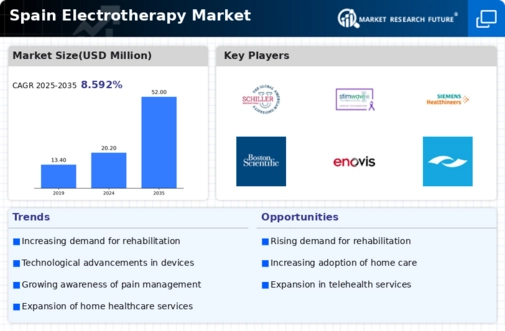The Spain Electrotherapy Market is characterized by heightened competition as firms strive to innovate and meet the growing demand from healthcare providers. This market encompasses a variety of therapeutic devices that utilize electrical stimulation for pain management, rehabilitation, and other medical applications. With advancements in technology driving the development of more effective and user-friendly products, companies are increasingly focused on differentiating themselves through unique offerings and improved functionalities.
The competitive landscape is shaped by evolving healthcare regulations, the need for clinical evidence and efficacy, and the drive to enhance patient outcomes. The presence of both local and international players offers a vast array of choices for consumers, leading to an ecosystem that places a premium on quality, effectiveness, and affordability in electrotherapy solutions.
In this competitive environment, Schiller stands out as a significant player in the Spain Electrotherapy Market, leveraging its robust portfolio and established reputation. Known for its reliable and innovative medical devices, Schiller has made substantial investments in research and development, allowing it to introduce advanced electrotherapy products tailored to the specific needs of the Spanish healthcare system.
The company possesses a strong distribution network in Spain, providing healthcare professionals with easy access to its electrotherapy solutions. Schiller's emphasis on high-quality standards and compliance with regulatory norms reinforces its position as a trusted brand among healthcare providers. Its focus on education and training further enhances its appeal, enabling clinicians to maximize the benefits of Schiller's electrotherapy products.
Stimwave is another notable player in the Spain Electrotherapy Market that has carved a unique niche with its pioneering approach to pain management solutions. Specializing in wireless neuromodulation technology, Stimwave offers groundbreaking products that provide effective and minimally invasive options for patients suffering from chronic pain.
The company has strategically positioned itself within the Spanish market by emphasizing the unique advantages of its key offerings, which include the Stimwave Percutaneous Peripheral Nerve Stimulation (PPNS) devices. Stimwave's innovative technology not only improves patient outcomes but also stands out due to its streamlined design that reduces the need for surgical interventions.
The company has actively engaged in partnerships and collaborations with local healthcare institutions to facilitate the integration of its devices into clinical practice, further solidifying its market presence. Additionally, Stimwave's commitment to enhancing patient care through continuous innovation and competitive pricing has contributed significantly to its strengths in the Spanish electrotherapy landscape.



















